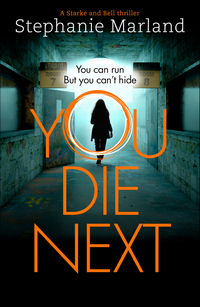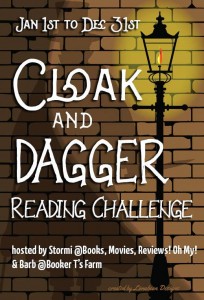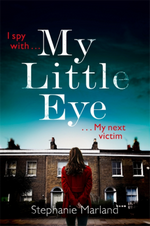If you have not read Stephanie Marland’s My Little Eye, you shouldn’t read this post, because I don’t know how much I might let slip, and while you probably can enjoy this book without having read it — you won’t appreciate it the way you should. Also, you should reconsider your life choices from the last year or so, because My Little Eye was one of the best things that was published in 2018.
—
 You Die Next
You Die Next
by Stephanie Marland
Series: Starke & Bell, #2Kindle Edition, 336 pg.
Hachette Book Group, 2019
Read: April 18 – 22, 2019

The tunnel would be pitch-black without the safety lights, but even with them Dom, Parekh and Timber have to tread carefully, using their torch beams to scan the rails for signs of blood. Back on platform five, the CSIs are working their magic. Once Dom’s established the route taken by Thomas Lee, they’ll start work on the tunnel as well. They need to move fast, find leads as to what the hell happened here. This has to be one of the most bizarre crime scenes that Dom’s attended.
Given the crime scenes we know Dom’s seen? That’s saying something.
I’ll admit, I wasn’t sure how Marland was going to proceed with Starke and Bell. Sure, teaming up the amateur and the Police Detective once is believable, but how do you do it again without it coming across as contrived? It’s not as if DI Bell can call her up, “Say, Clementine…I’ve got this real puzzler of a case that’s got me stumped, you think you and your pals can take a crack at it?” without violating so many rules and regulations that he wouldn’t have a job long enough to arrest anyone. Marland makes the smart choice — she put them in each other’s rearview mirrors.
Starke’s off on her next research project, lamenting the notoriety that she earned (and enjoyed) after the events of My Little Eye, dealing with university politics, deadlines, and continuing to research her father’s death with the True Crime online group. She’s currently studying thrill-seekers and voyeurs, the genesis of their obsession and what feeds it. A fan of her work (for lack of a better term), keeps trying to get her to look into Urban Explorers. She finally gives in, just to get him off her case about it (she hopes), and watches a video he insists she watch. While doing so she sees two things — first, that he’s probably right, they’d make good subjects for her research; and second, she’s pretty sure she sees a murder. Which settles things — Clementine Stark dives into the world of Urban Explorers in general and those on the video in particular.
Bell’s working various cases, trying to decide what to do with his DS post-My Little Eye, and worried about the internal investigation about that case that went so wrong before the last book that still wreaks havoc on almost every relationship in his life. He’s called out to the scene of a car striking and killing a pedestrian — not really his kind of case, if not for the fact that the pedestrian probably would’ve been killed by the stab wounds all over him if the car hadn’t sped his death along. Meanwhile, as I said, the look into Operation Atlantis continues and the strain on his relationship with his sister is such that it’s at the breaking point, and Bell’s ex is pushing him for information on the investigation into the operation. Bell’s close to putting things together, and when he does, this ugly situation is probably only going to look worse for everyone.
It’s on the back-of-the-book blurb, so I feel I can say this without giving away too much — Bell’s pedestrian is one of the Urban Explorers that Starke’s looking into. So again, they’re working the same case, but don’t know it — and are approaching it from very different angles. But Starke also observes some of the people involved in that Operation Atlantis raid that went so horribly wrong, clearly plotting and planning about what to do about Bell — how to exploit him at the very least. Whatever went wrong between them, Starke’s not going to let anything happen to Bell if she can help it. So, again, the two are working the same case from different angles. There’s another thing they will have in common, too — but I’m not going to get into it beyond saying it exists. But let’s just say there are really three mysteries being investigated in this book, and both Starke and Bell have a stake in all three, but aren’t really working together on any of them.
That sounds confusing, maybe like a little narrative overkill, too. But it’s not, Marland weaves these six storylines together perfectly — actually, there are more than six, but they can be boiled down to six without losing much, if I tried to diagram it exactly, I’d end up with something looking like one of those cork-boards covered in newspaper clippings, note cards and photos tied together with strings between connections that were so popular on TV a few years ago. (and that Starke has in her apartment, come to think of it). I lost my point there — Marland artfully weaves/juggles the various stories into a cohesive whole in a way that doesn’t overwhelm the reader and keeps the reader engaged with all the various mysteries, plot advances, character moments, etc. It’s a real feat that she pulls off with aplomb.
I’m going to be haunted by the conclusion for a while. It reminds me of something I read in December 2017, and frankly, haven’t shaken yet (I’ll not mention the title, because doing so might tell you more about the conclusion than I want to). It’s the only way this book really could end — and I’m not complaining about it at all — but it’s going to linger longer than most do in the back of my mind.
I want to talk about some of the supporting characters — and Bell’s DS and DC, in particular, really deserve more attention than I’m paying them. But I’m going to skip that this time. I just don’t have enough time to do them justice. While Starke and Bell are fascinating, complex characters that any reader will enjoy digging into, the same is true for the people around them. They’re pretty well fleshed out, and you can easily imagine that Marland has plans for their future use. Any of the secondary or tertiary characters in this series could become very important in future events and should probably be paid attention to by readers (which is easy, because even the one who might as well be named Lecherous Scumbag is a character you can enjoy reading).
I’ve managed to only use the word “obsession” once so far — which is surprising. Not only is it the focus of Starke’s research, obsession can be used in some way to talk about every story, every idea, every character in You Die Next.. The person hunting down Urban Explorers is clearly obsessed with whatever their motivation is. Bell’s obsession over whatever investigation he’s pursuing has damaged romantic relationships, his relationship with his sister, and even his career. Starke’s obsessions with her work, Bell, her father’s death, this possible murder she saw, and . . . well, really — what isn’t she obsessed with? This book is permeated with notions of, examples of, and the repercussions of obsession.
In both concept and execution, Marland tried to accomplish a lot in My Little Eye and succeeded. You Died Next strikes me as more ambitious than its predecessor, making it harder to pull off — the bar was set pretty high and she moved it up. I’m not sure Marland was as successful with this novel as she was with My Little Eye, but I can’t point at any part of this book and say “this could be better here.” I think my hesitancy about this book comes from so much of the conclusion of this novel pointing to the third installment. My Little Eye told a story, with the potential for more. You Die Next told a story, but kept the resolution to much of it dangling. If we didn’t get You Die Next, for whatever reason, My Little Eye could stand on its own. Without Starke & Bell #3, You Die Next is the novel equivalent of “Shave and a Haircut”/Tum-ti-ti-tum-tum without the “Two Bits”/Tum-tum.
And by not as successful, I think I’m saying this is more of a 4.25-4.35 than a clear 4.5.
I may not be the biggest fan of every choice that Marland made for these two in this book, but they were honest choices entirely consistent with the characters — and will lead to a whole lot of exciting narrative possibilities in Starke & Bell #3 (and beyond, if there is a beyond). Either of these characters could anchor a pretty decent series on their own, together they make a special kind of magic. Their continued interaction may not do them a lot of good, but it will prove destructive to more than one criminal in London — and a whole lot of fun for readers. You Die Next brings the two characters together in a way that highlights their strengths (and weaknesses), pitting them against a cold and clever killer and a criminal conspiracy (or two) more widespread and powerful than they yet realize. I haven’t read a whole lot this year that I’d call a must, but this is. Stop wasting your time on my stuff and get this in front of your eyes.
—–

![]()




